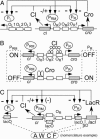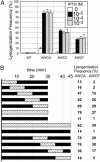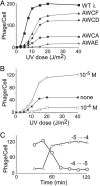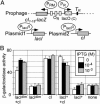Role of the lytic repressor in prophage induction of phage lambda as analyzed by a module-replacement approach
- PMID: 16537413
- PMCID: PMC1450210
- DOI: 10.1073/pnas.0511117103
Role of the lytic repressor in prophage induction of phage lambda as analyzed by a module-replacement approach
Abstract
Using a module exchange approach, we have tested a long-standing model for the role of Cro repressor in lambda prophage induction. This epigenetic switch from lysogeny to the lytic state occurs on activation of the host SOS system, which leads to specific cleavage of CI repressor. It has been proposed that Cro repressor, which operates during lytic growth and which we shall term the lytic repressor, is crucial to prophage induction. In this view, Cro binds to the O(R)3 operator, thereby repressing the cI gene and making the switch irreversible. Here we tested this model by replacing lambda Cro with a dimeric form of Lac repressor and adding several lac operators. This approach allowed us to regulate the function of the lytic repressor at will and to prevent it from repressing cI, because lac repressor could not repress P(RM) in our constructs. Repression of cI by the lytic repressor was not required for prophage induction to occur. However, our evidence suggests that this binding can make induction more efficient, particularly at intermediate levels of DNA damage that otherwise cause induction of only a fraction of the population. These results indicate that this strategy of module exchange will have broad applications for analysis of gene regulatory circuits.
Conflict of interest statement
Conflict of interest statement: No conflicts declared.
Figures




Similar articles
-
On the role of Cro in lambda prophage induction.Proc Natl Acad Sci U S A. 2005 Mar 22;102(12):4465-9. doi: 10.1073/pnas.0409839102. Epub 2005 Feb 23. Proc Natl Acad Sci U S A. 2005. PMID: 15728734 Free PMC article.
-
Cro's role in the CI Cro bistable switch is critical for {lambda}'s transition from lysogeny to lytic development.Genes Dev. 2007 Oct 1;21(19):2461-72. doi: 10.1101/gad.1584907. Genes Dev. 2007. PMID: 17908932 Free PMC article.
-
Bacteriophage λ RexA and RexB functions assist the transition from lysogeny to lytic growth.Mol Microbiol. 2021 Oct;116(4):1044-1063. doi: 10.1111/mmi.14792. Epub 2021 Aug 30. Mol Microbiol. 2021. PMID: 34379857 Free PMC article.
-
Yet another way that phage λ manipulates its Escherichia coli host: λrexB is involved in the lysogenic-lytic switch.Mol Microbiol. 2015 May;96(4):689-93. doi: 10.1111/mmi.12969. Epub 2015 Mar 16. Mol Microbiol. 2015. PMID: 25684601 Review.
-
lambda Repressor and cro--components of an efficient molecular switch.Nature. 1981 Nov 19;294(5838):217-23. doi: 10.1038/294217a0. Nature. 1981. PMID: 6457992 Review.
Cited by
-
Stability and instability in the lysogenic state of phage lambda.J Bacteriol. 2010 Nov;192(22):6064-76. doi: 10.1128/JB.00726-10. Epub 2010 Sep 24. J Bacteriol. 2010. PMID: 20870769 Free PMC article.
-
Lysogen stability is determined by the frequency of activity bursts from the fate-determining gene.Mol Syst Biol. 2010 Nov 30;6:440. doi: 10.1038/msb.2010.96. Mol Syst Biol. 2010. PMID: 21119634 Free PMC article.
-
Characterization of a T4-like Bacteriophage vB_EcoM-Sa45lw as a Potential Biocontrol Agent for Shiga Toxin-Producing Escherichia coli O45 Contaminated on Mung Bean Seeds.Microbiol Spectr. 2022 Feb 23;10(1):e0222021. doi: 10.1128/spectrum.02220-21. Epub 2022 Feb 2. Microbiol Spectr. 2022. PMID: 35107386 Free PMC article.
-
Lambda-prophage induction modeled as a cooperative failure mode of lytic repression.Phys Rev E Stat Nonlin Soft Matter Phys. 2009 Sep;80(3 Pt 1):030901. doi: 10.1103/PhysRevE.80.030901. Epub 2009 Sep 1. Phys Rev E Stat Nonlin Soft Matter Phys. 2009. PMID: 19905052 Free PMC article.
-
Guidance for data collection and computational modelling of regulatory networks.Methods Mol Biol. 2009;541:337-54. doi: 10.1007/978-1-59745-243-4_15. Methods Mol Biol. 2009. PMID: 19381541 Free PMC article. Review.
References
-
- Herskowitz I., Hagen D. Annu. Rev. Genet. 1980;14:399–445. - PubMed
-
- Ptashne M. A Genetic Switch: Phage Lambda Revisited. Woodbury, NY: Cold Spring Harbor Lab. Press; 2004.
-
- Kourilsky P. Mol. Gen. Genet. 1973;122:183–195. - PubMed
-
- Roberts J. W., Devoret R. In: Lambda II. Hendrix R. W., Roberts J. W., Stahl F. W., Weisberg R. A., editors. Woodbury, NY: Cold Spring Harbor Lab. Press; 1983. pp. 123–144.
Publication types
MeSH terms
Substances
Grants and funding
LinkOut - more resources
Full Text Sources

